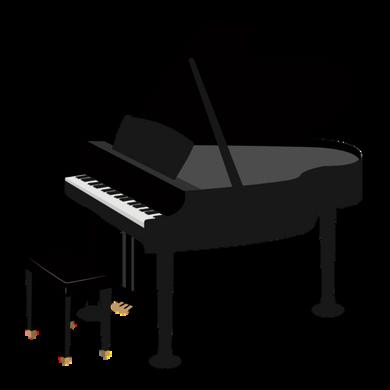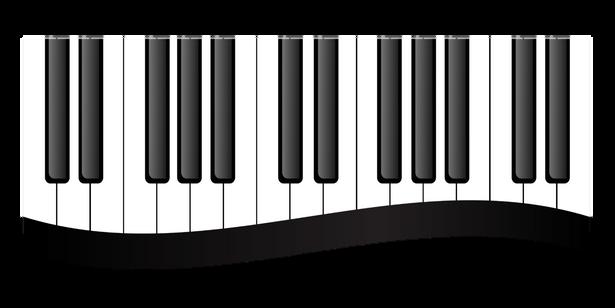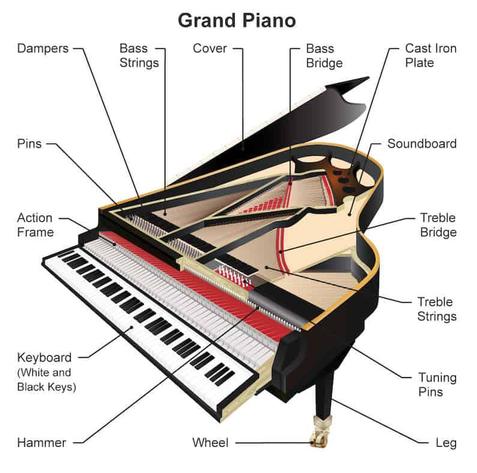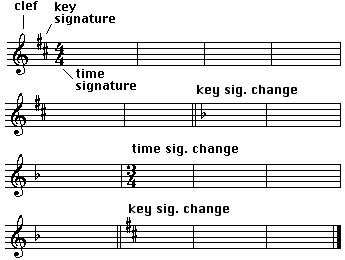



Tothosewhousewellwhattheyaregiven,evenmorewillbegiven,andtheywillhaveanabundance. Butfromthosewhodonothing,evenwhatlittletheyhavewillbetakenaway. Matthew25:29





Tothosewhousewellwhattheyaregiven,evenmorewillbegiven,andtheywillhaveanabundance. Butfromthosewhodonothing,evenwhatlittletheyhavewillbetakenaway. Matthew25:29
Thepiano,alsoknownasthepianoforte,Frenchpiano,orpianoforte,GermanKlavier, is a keyboard-controlled musical instrument with wire strings that produce sound when struck by hammers coated in felt. The typical modern piano has 88 keys, a rangeofsevenfulloctaves,andafewmorekeys
Abridgeoverwhichthestringsarestretchedtransmitsthevibrationofthestringsto a soundboard, which amplifies the sound and influences the tone quality. The mechanism serves to speed up the motion of the hammer, catch it as it rebounds from the strings, and hold it in position for the next attack. The hammers that strike the strings are attached to a mechanism resting on the far ends of the keys; the hammer and mechanism together make up the "action." Felt now covers hammers, whereas leather was once the material of choice. Unlike early pianos, which had woodframesandcouldonlybelightlystrung,modernpianoshavecast-ironframes that can handle the extreme stress of the strings. As a result, contemporary pianos are significantly louder than those from the 18th century This rise in volume was madenecessaryinpartbythesizeofperformancehallsinthe19thcentury.Theleft pedalmovesthekeyboardandactionsidewayssothatthehammercanonlystrike one of the two or three unison strings of each tenor and treble key (the bass notes are only single-strung); the middle pedal, which is typically found on grand pianos but can also be found on some upright pianos, typically holds up the damped felt dampers above the strings, allowing them all to vibrate freely (The Editors of EncyclopediaBritannica,2018)
Acousticpianos(whethercabinetsorgrandpianos)haveanelegant allure Thecasingandlidserveapurposethanlooksgood Together theymakeuptheframethathousesthesound-generating mechanismofthepiano.

Casingsareconstructedbygluingseveralsheetsoffinewood, whicharethencutintoaparticularshape.Thesurfaceofthe woodissandeddownuntilit’ssmoothandcoatedwith polyurethane,givingitaglossyfinish
Thelids’designfacilitatestuningthepianoandamplifiesits sounds.
Legs elevate the piano to a suitable height, enabling musicians to play the instrument comfortably. The legs are solid wood (usually birch or maple) to hold the piano’s body, sometimesweighingover1000pounds.
Instrument-makers include wheels at the base depending on the piano to easily move it shortdistances
The keyboard is the point of interaction between the musician and the instrument. A musician triggers a mechanism that produces unique and rich sounds by pressing on a givenkey.

Apianotypicallyhas88weightedkeysdividedinto52whiteand36black.Thekeyboardhas sevenoctaves–twelvekeys,sevennaturalnotes,andfivesharporflatnotes.
Modernkeyboardshaveplastickeys.However,olderpianosweremadewithebonyandivory keys
Thesourceofthepiano’ssoundliesinaseriesofsteelstringstightlywoundfromoneendof theinstrumenttotheotherwithinthecasing.
There are approximately 230 strings on a given piano Two-thirds of the string make up the tenor and treble section and are made with plain drawn steel, while the last third, which makesupthebasssection,iswoundwithcopper.
4.TheHammers

The felt-covered hammers are at the heart of sound creation and are part of what makes the piano a percussion instrument. They’re an essential part of the mechanism that connects the piano’skeysandstrings.
Thehammerisasophisticateddevicethathasseveralparts:
Knuckle Shank
Flangeandflangerail
Dropscrew
Escapement
Hammerhead
5.TheSoundboard
Like a violin, cello, or acoustic guitar, part of the sound amplification lies in the piano soundboard.

Thesoundboardisalarge,thinwoodenplateinwhichthe soundproducedbythestringscanechoorradiateover awidefrequencyrange.Likethecaseandlid,wemake thesoundboardbygluingseveralpiecesofSitkaspruce together
6.ThePedals
Modernpianoscomewiththreesoft,sostenuto,ands ustainpedals.
Theleftmostpedalisthesoftpedal(unacorda) Itshiftsthe actionwhenpressingdownonit,soitonlystrikesasinglechord, makingthepianoplaysoftly.
The sostenuto pedal (the latest pedal addition to the piano) is in the middle The sostenuto pedalsustains(holdsforalongtime)notesthatyouplay Andontherightisthesustainpedal. Likethesostenutopedal,whenyouholdthe sustainpedal,itcausesthesoundsto resonateforlonger.
Whilepianosmaylooksimilar,instrument-makers usedifferentmaterialsdependingonthemodel andtypeofpiano.Therefore,therearemany pianoswithdifferentdesignsandlooksthatoffer differentsounds,looks,andsensations(Brown,2022)
Trivia
On modern piano keyboards, the seven " natural" notes of each octave are the white keys and the five half-tones are black keys in between.
But, on pianos dating from the 18th century when
Mozart was alive, the colors of the keys was exactly reversed: the white keys were black and the black keys were white. This was true n
and cembalos of the time. They were the opposit
today.
Along with major chords, minor chords are the first type of chords one learns as a piano or keyboard student They are among the most basic and easiest of chords to play on the piano When learning to play piano, start withmajorthenmovetominortriadsorchords
Thistypeofchordiscalledatriadduetothefactthatithasonlythesethreenotes:aroot,aminorthirdanda perfectfifth Forexample,thechordAminorconsistsoftherootnote,A,aminorthird,C,andaperfectfifth,E The minorthirdis3halfstepsabovetherootnote,whiletheperfectfifthis7halfstepsabovetherootnote,or4half stepsabovetheminorthird(HowtoPlayMinorChordsonPiano–PianoChords,nd)

Music can be written in a variety of ways. Less intricate systems exist which only indicate thebasicstructure(chordchanges)ofasongandrequirethereadertoalreadyknowthe melody or improvise one, while more formal systems allow for carefully indicating each sound to make and also when to be tacit (silent), and the respective durations of each ThevastmajorityofWesternmusicinthemoderneraiswrittenusingasystemofnotation where each sound is represented by a symbol called a note which is placed within an arrangementoffiveparallellinesrunninghorizontallyknownasastaff,wherethelinesand spaces between them each correspond to a consecutive pitch (acoustic frequency) in a scale, with lower pitches at the bottom and higher ones at the top The specific symbol used for each note indicates its duration, and other symbols called rests indicate the lengthsofsilencebetweenthem,ifany.
Thefirstsymboloneverystaffisasymbolcalledaclef,whosefunctionistoidentifyoneof the lines of the staff as representing a particular note. Pianos, able to play notes ranging overmanyoctavessimultaneously,usuallyhavemusicwrittenwithtwostaves,eachwith a different clef The treble clef, or G clef, is used for the higher sounding notes, usually played with the right hand. The bass clef, or F clef, is used for the lower sounding notes, usually played with the left hand. When the two staves are joined on the left by a brace, theyarecollectivelycalledagrandstaff.
 (PinonTrebleandBaseClefLines,n.d.)
(PinonTrebleandBaseClefLines,n.d.)




Written music is organized into measures separated by barlines There are several types of barlines The most common barline is a single vertical line that separates the music into measures. The sum of the rhythm values of every note in the measure has to add up to the valuesspecifiedbythetimesignature.Adoublebarlineisusedtoindicatelargesubdivisionsof the musical form. The final barline is written as a thin barline followed by a thick barline and is usedattheendofeverypieceofmusic

Thick and thin barlines are also used for repeat signs. Repeat signs usually appear in pairs and looklikeafinalbarlinewithtwodotsplacedinthesecondandthirdspaces.Themusicbetween therepeatsignsisplayedtwice.

The left repeat marks the beginning of the repeated section and faces right The right repeat markstheendoftherepeatedsectionandfacesleft.
In the absence of a left repeat sign, the repeat goes all the way back to the beginning of the music

Sometimes the music will indicate a first and second ending. The first ending is played the first time through the repeat. The second time through the repeat, the first ending is skipped, the secondendingisplayedandthemusiccontinuesfromthere.
Threenotationelementsappearinthefirstlineofeverypiecemusic:theclef,thekeysignature, and the time signature. The clef and key signature appear at the beginning of every line of music. The time signature appears only on the first line and is not written again until it is changed

Timesignaturesareoneofthemostimportantindicationsinnotatedmusic.Weusethemto helporganizeandmeasuremusic Theyhelpusdividemusicintophrasesandmakeiteasier tomemorizeandunderstandmorecomplexpassagesandsongs Withoutthem,measuresin notatedmusicwouldrunonforever,muchlikeasentencewithoutanysortofpunctuation.
Timesignaturesconsistoftwoelements:atopnumberandabottomnumber.Thetop numbertellsusthenumberofbeatsineachmeasure.Thebottomnumberintimesignature tellsyouwhatnotevaluesthosebeatsare Ifthebottomnumberisa4,itmeansthebeatsare quarternotes(fourquarternotesinameasure) Ifthebottomnumberis2,itmeansthenote valueishalfnotes(halfnotespermeasure).Andifthebottomnumberisan8,itmeansthe beatsare8thnotes.

BasicsofMeter
meter is a recurring pattern of stresses or accents that provide the pulse or beat of music. Meterisnotatedatthebeginningofacompositionwithatimesignature.Timesignaturesare always notated with two numbers, one on top of the other, much like a fraction in math. The topnumberdenotesthenumberofbeatsineachmeasure Thebottomnumberdenotesthe note value that receives the beat The note values that can receive beats include double whole note, whole note (1), half note (2), quarter note (4), eighth note (8), sixteenth note (16), thirty-secondnote(32),sixty-fourthnote(64),andonehundredandtwenty-eighthnote(128).
MeterClassification
Meter can be categorized as simple, compound, or complex These three categories can explain all rhythmic patterns in Westernmusic. Each of the categories of meter is defined by the subdivision of beats. The number of beats per measure determine the term associated withthatmeter.

BeatsPerMeasure Term
2or6 duplemeter
3or9 triplemeter
4or12 quadruplemeter
everythingelse Complex
SimpleMeter
Simplemeter(simpletime)canbedefinedasameterwhereeachbeatinameasurecanbe subdividedbytwo.
CompoundMeter
Compountmeter(compoundtime)canbedefinedasameterwhereeachbeatinameasure canbesubdividedbythree Itiscommonlydistinguishedbydottednote(OnMusicDictionary -Topic,n.d.).
DifferentkindsofAccidentals
Anaccidentalisasigntoraiseortolowerthepitchofamusicnote.
Belowarethemostcommonaccidentals:
Sharp
When added to a note, a sharp ( ♯ ) raises the note by a half step united states of america (semitoneunitedkingdom).
Flat
Whenaddedtoanote,aflat(♭)lowersthenotebyahalfstep
Natural
Whenaddedtoanote,anatural(♮)cancelsthepreviousaccidentals. (Accidentals-MusicTheory,nd)
Dynamics
Dynamics means how quietly or loudly a piece of music shouldbeplayed
Dynamicsareanimportantwayofconveyingthemoodof apieceandyouruseofdynamicsisamarkedelementof yourperformance
Composers use dynamics to change the mood. Sometimes a piece will have very few dynamics and others will have many changes (DynamicsUnderstanding Musical Terms - National 5 Music Revision, nd)

Dynamics in music are very important because they can addalotofemotiontoapieceofmusic.
The dynamics of a piece of music can help to wake you up,canhelptoputyoutosleep,canhelptomotivateyou togetdancing,orevenhelpyoutoconcentrateandstudy (Julia,2020).
Tempo
Tempoinmusicisthespeedorpaceofasong It ismeasuredinbeatsperminute(BPM).Tempois an essential element of music because it sets themoodandenergyofthesong.Itcanmakea song sound upbeat, energetic, or slow and mellow
Tempo also affects how the listener perceives thesong,asitcanmakeitsoundfasterorslower than it actually is. As such, tempo is a powerful tool for creating different atmospheres and emotionsinasong
Generally,aslowertempowillhavealowerBPMandafastertempowillhaveahigherBPM(Gateway,2019)

Accidentals-Musictheory (nd) Wwwdacapoalcodacom https://wwwdacapoalcodacom/accidentals
Brown,K (2022,August7) The6DifferentPartsofaPiano Learn toPlayanInstrumentwithStep-By-StepLessons|SimplyBlog https://wwwhellosimplycom/blog/pianos/pianoparts/#: :text=The%20general%20parts%20of%20the
Brown,K (2022,March22) QuicklyLearnPianoNotesand Chords LearntoPlayanInstrumentwithStep-By-StepLessons |SimplyBlog https://wwwhellosimplycom/blog/pianobeginner/quickly-learn-piano-notes-and-chords/
Dynamics-Understandingmusicalterms-National5Music Revision (nd) BBCBitesize
https://wwwbbccouk/bitesize/guides/zq6nrwx/revision/3#: :t ext=Dynamics%20means%20how%20quietly%20or
Gateway,M (2019,August22) TempoInMusic:WhatIsIt&Why
IsItImportant?MusicGateway
https://wwwmusicgatewaycom/blog/music-theory/tempoin-music-what-is-it-why-is-it-important
HowtoPlayMajorchordsonPiano–PianoChords (nd) http://wwwpiano-keyboard-guidecom/major-chordshtml
HowToPlayMinorChordsonPiano–PianoChords (nd) RetrievedMay19,2023,fromhttp://wwwpiano-keyboardguidecom/minor-chordshtml
https://twittercom/HollywoodPiano/status/1406324523788500
995 (nd) Twitter RetrievedMay19,2023,from https://twittercom/HollywoodPiano/status/1406324523788500
995
Julia (2020,October25) WhatareDynamicsinMusic?Jooya TeachingResources https://juliajooyacom/2020/10/26/whatare-dynamics-in-music/
MUSC101-04Notation2 (nd) Peoplecarletonedu Retrieved May17,2023,from https://peoplecarletonedu/~jellinge/m101s12/Pages/04/04Not ation2html
Notes&Rests (nd) Piano1 RetrievedMay17,2023,from https://jspianofinalweeblycom/notes--restshtml
OnMusicDictionary-topic (nd) Dictionaryonmusicorg https://dictionary.onmusic.org/appendix/topics/meters
PinonTrebleandbasecleflines (nd) Pinterest RetrievedMay 17,2023,from https://wwwpinterestph/pin/505810601907464091/
TheEditorsofEncyclopediaBritannica (2018) Piano|musical instrument InEncyclopædiaBritannica https://www.britannica.com/art/piano
Trivia:TheWhiteKeysandBlackKeysWereReversedon PianosinMozart’sDay-MusicalInstrumentGuide-Yamaha Corporation (nd) Wwwyamahacom Retrieved May19,2023, fromhttps://www.yamaha.com/en/musical instrument guide/piano/trivia/#:~:text=On%20 modern%20piano%20keyboards%2C%20the
Redeemed people committed and dedicated in building God’s Kingdom
To bring people to Christ and train them to Christ-like maturity.
PBC exists to bring people to Christ Jesus and membership in His family, develop them to Christlike maturity and equip them for their ministry in the church and life mission in the world in order to magnify God’s name
Email: pototanbaptistchurch 100@gmail com
Facebook Account: Pototan Baptist Church
Facebook Page: Pototan Baptist Church @pototanbaptistchurch.100
YouTube: Pototan Baptist Church
WEDNESDAY
PRAYER MEETING 4:00 PM
SATURDAY
CHOIR PRACTICE 3:00 PM
PRAISE AND WORSHIP PRACTICE 4:00 PM
SUNDAY
SUNDAY SCHOOL (ALL LEVELS) 8:30 AM
SUNDAY WORSHIP SERVICE 9:30 AM
SUNDAY VESPER WORSHIP SERVICE
(EVERY LAST SUNDAY OF THE MONTH) 5:00 PM